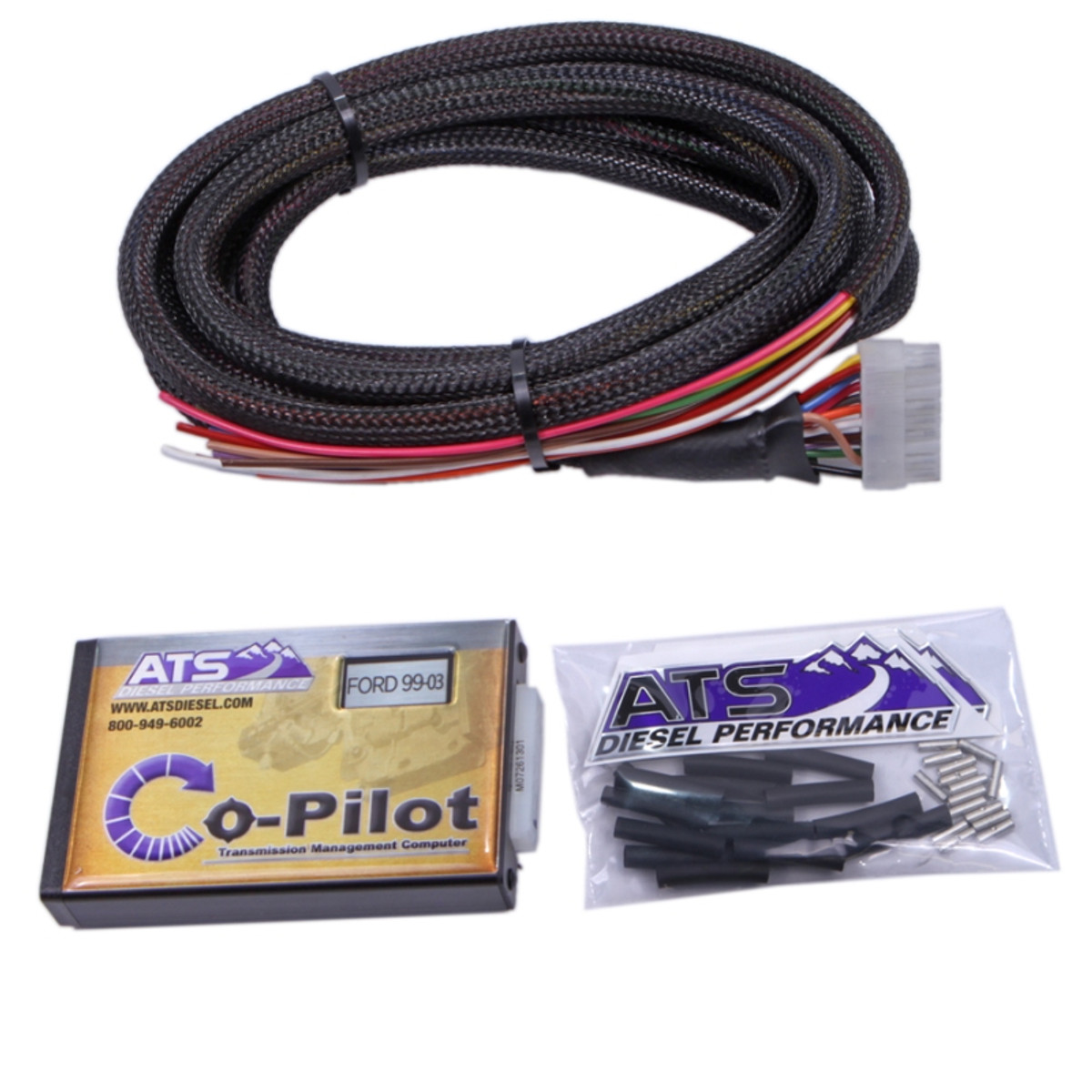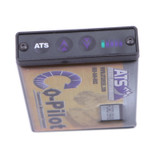

ATS Diesel Performance
ATS - Co-Pilot Transmission Kit - 1999-2003 Ford 7.3L Power Stroke with 4R100 6019003224

Refundable Core Charge: $400
More InformationTripleLok® Torque Converter - 1989 - Early 03 Ford 7.3L Power Stroke with E40D or 4R100
Part # 3029303104
The TripleLok® Torque Converter for 1989 to 2003 Ford PowerStroke is the only Diesel torque converter on the market that has been awarded two patents from the United States patent office. There is no other torque converter offered anywhere that can make this claim. The 30 square drive tabs that are precision CNC cut into the billet cover is only one of the many patented aspect of the TripleLok® converter. ATS engineered a unique two piece design that not only allows us to cut precision radial flank drive lugs into the cover but also utilizes a plasma weld ensuring an unmatched quality standard. The patented radial flank drive tabs virtually eliminate the wear that is common with all other round tab multi-disc torque converters. This is the number one reason ATS can offer a 5 year warranty on all our torque converters.
Features of the TripleLok® torque converter are:
There are a few things that I would like to tell you about this torque converter. In 1999 the first Diesel multiple disc converter was developed utilizing round tabs to connect the clutch plates to the cover. We soon realized this to be a problem, after several thousand miles the outer plate would start to hammer into the billet cover due to the engine piston pulsations. These pulsations are engine torsional loads that will destroy a converter and flex plate.
We soon invented and patented the Square tab design that you can see and only get from ATS today. The Radial Flank Square Tab is the back bone of the ATS TripleLok® and FiveStar® torque converter, all ATS multiple Disc converters are 100% square tab construction. The Billet cover provides a multitude of benefits, having the thick steel cover provides a base that will not flex. This is very important when needing a flat surface for the Lock-up clutches to couple with, this is also very important during times when there are high pressures created inside the converter due to extended load times when the converter is in a vortex flow. This pressure will cause the converter to balloon and the thrust bearings to get out of alignment causing converter failure.
The triple clutch lock-up system is used to transfer torque from the engine to the transmission during high power applications when the converter is in lock-up. The triple clutch provides three times the torque capacity of a standard single disc converter and ensures there will be no slipping during hard accelerations or when pulling heavy loads.
There are basically two areas of operation in a torque converter. The fluid coupling portion and the lock-up portion. The fluid coupling section is the operation that takes place when you accelerate from a stop when the engine is spinning and the vehicle wheels are not moving or just starting to move. As you push on the accelerator pedal and the vehicle starts to move this is considered the torque converter stall speed. Once the stall speed is reached and the vehicle starts to move forward the converter is in what we refer to as the VORTEX flow condition of the converter cycle. The VORTEX flow cycle is one of the most important and over looked segments of a converter. When in this cycle the impeller is picking up fluid and slinging it into the turbine. As the turbine catches the accelerated fluid the turbine is forced to spin turning the input shaft of the transmission. After the fluid is spun through the turbine it is redirected into the Stator. At this point the Stator must redirect the fluid back into the impeller in an efficient manner or the converter will build excessive heat and acceleration will be poor. This is the magic of the Stator, A stator MUST be designed properly or the fluid coupling of the converter will be poor and drive-ability and acceleration will suffer. This is in a large part what you will experience from a stock converter.
The construction of the stator is a key component in the TripleLok® converter, we CNC machine the stator to allow fluid to be picked up from the turbine in a manner that will not disrupt the fluid flow and efficiently change the fluid direction so it will be channeled into the impeller with out tumbling. Comprehensive computer annalists are used to achieve the perfect vane profile providing optimal stall speed while maximizing torque multiplication. All this math and precision matching of parts provides the best possible acceleration and a smooth transition into lock-up.
As the vehicle is accelerated into the higher gears and the fluid portion of the converter transfers from a vortex flow to a rotary flow all torque converters start to loose their efficiency. This transitional area is where the Patented ATS FiveStar® torque converter really provides a benefit over the TripleLok® torque converter. As the converter is commanded to go into lock up there is a mechanical connection made between the engine and the transmission. Stock converters and most after market converters have only one lock up disc, having only one lock up clutch surface limits the converters ability to hold torque.
As a transmission gets higher mileage on it or when engine power is turned up the torque converter clutch looses its ability to hold its traction to the engine causing a slipping condition that quickly destroys the converter and the transmission. This is the reason to add two additional clutches to the converter to allow for three times the torque capacity.
When additional clutches are added to a converter the clutch plate that is connected to the engine is subject to severe engine torsionals as the engines piston pulsations try to tear apart the converter. These piston pulsations push and rattle on the engagement tabs of the steel clutch plate. Back in 1999 when we first placed a multiple clutch converter behind a diesel engine we quickly discovered that we had a problem. The Diesel engine would wear out the round tabs of the clutch disc causing metal contamination and transmission failure. ATS found a way around this premature wear by inventing and patenting the Square Radial Flank Drive clutch system that you see in the TripleLok® and FiveStar® converters today.
Clutch material and the way the clutch material is bonded to the steel plates is a critical step in manufacturing. Clutch material can be broken into two basic principles, its ability to hold and transfer heat and its coefficient of friction. The coefficient of friction is the measurement of the traction it will have to its mating surface. A friction material that has a very high coefficient of friction makes an extremely good engagement while a friction with a very low coefficient of friction will slip under heavy load. So it would make sense that one would always choose the high coefficient friction material but this does not make a good choice because this material is always a cellulose material better known as PAPER. Paper is the choice of all auto manufacturers and almost all after market torque converter manufacturers.
On the other end of the scale is Kevlar friction material, although Kevlar is almost indestructible the coefficient of friction of Kevlar is very low and a constant slip is unavoidable. These two frictions composites leave a lot to be desired when your looking for the optimal in friction coefficient, wear and heat transfer.
ATS went to work with a well-known US friction manufacturer and specially formulated a ATS only exclusive friction material that we use in our TripleLok® and FiveStar® torque converters. We also use an epoxy to attach the friction material to the steel plates instead of the industry standard glue that is prown to delamination from heat or water contamination that is widely present in many transmission applications.
In short, The TripleLok® torque converter is only surpassed by the FiveStar® torque converter for many reasons. The highlights of the TripleLok® converter are listed above but there are many other attributes that are not talked about that make these converters second to none and a pleasure to drive. We encourage you to talk with one of our technical sales specialist if this summary does not answer your questions. On last thing I would like to add, our converters are made with American labor and American pride in our American plant.

WARNING : This product can expose you to chemicals including arsenic, which is known to the State of California to cause cancer. For more information, go to www.P65Warnings.ca.gov